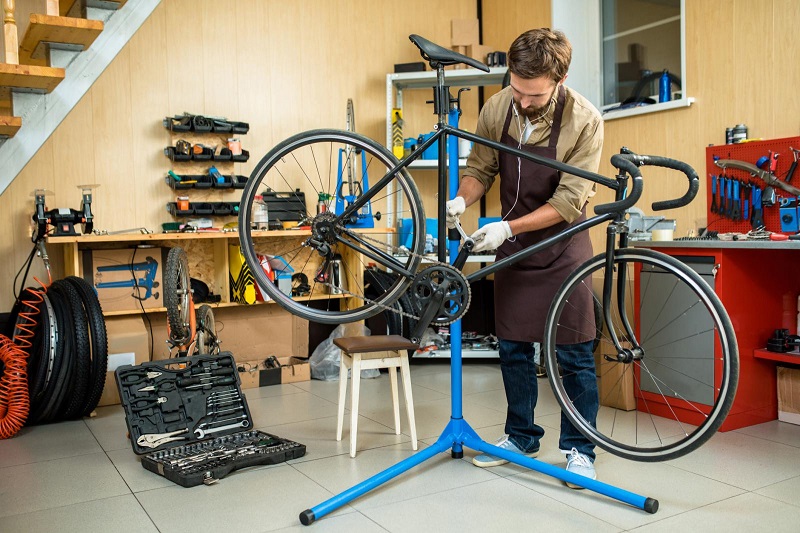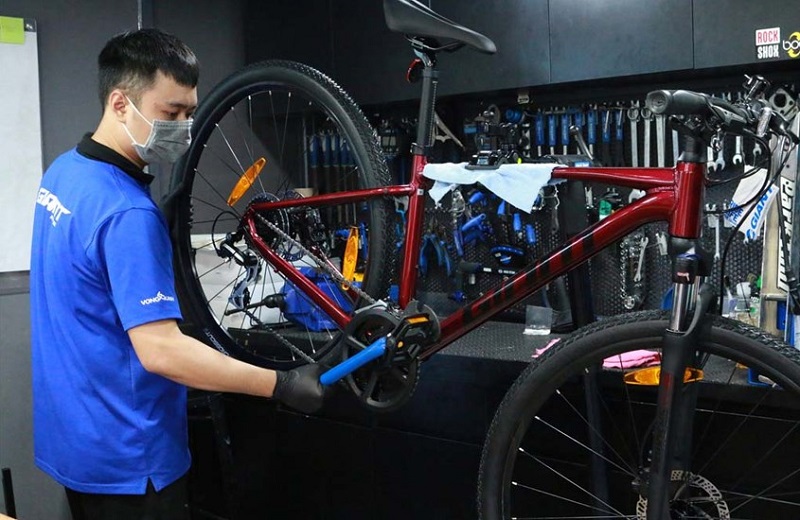Guidance
How To Repair A Broken Bike Frame?
Bike frames are the backbone of your bicycle, providing the necessary structure and support for all its components. Like any piece of machinery, though, they are susceptible to damage. This guide of HookBike outlines how to repair a broken Bike Frame, ensuring your bike remains in top shape and is safe for your rides.
Understanding the Frame Materials of bicycles
The frame is an important component of a bicycle, as it determines the bike’s structure, contributing significantly to its weight, handling, and ride quality. Different materials offer different advantages and disadvantages depending on the type of bike desired and the intended use. Here is a list of the most common bicycle frame materials:
Aluminum Frames
Aluminum is a popular material for bike frames due to its lightweight and resistance to rust. However, it can be more susceptible to cracks and dents.
Steel Frames
Steel is heavier but offers strength and flexibility. It’s more forgiving to minor bends but can rust if not properly treated.
Carbon Fiber Frames
Carbon fiber frames are lightweight and strong but can be prone to cracks if impacted.
Titanium Frames
Titanium blends the lightweight benefits of aluminum with the strength of steel, making it an ideal but pricier option.
When choosing a bicycle frame material, consider the bike’s intended use, the desired ride quality, weight, and your budget. Each material has its unique characteristics and will provide a distinct ride experience.

Assessing the Damage of the bicycle frame
Assessing bicycle frame damage is crucial to ensure the safety and functionality of the bike. Damaged frames can pose serious safety hazards to the rider. Here are steps and key points to assess frame damage:
Visual Inspection
Check for visible cracks, dents, or deformations. Remember, even minor-looking damage can compromise the integrity of a frame.
Pay close attention to the joints and welding/bonding areas, as these are common spots for potential damage.
Look for signs of corrosion, especially in steel frames. Rust can weaken a frame over time.
Feel
Run your hand over the frame, especially in areas that look suspicious. Sometimes a crack or dent is more easily felt than seen.
Listen
Gently tap the frame with a plastic tool (like the handle of a screwdriver). A change in the sound could indicate a crack or other internal damage. This method is particularly effective for carbon frames.
Alignment Check
Check if the wheels are aligned. If they’re not parallel, there might be an alignment issue with the frame or fork.
Use an alignment gauge or take the bike to a professional to check if the dropouts are aligned.
Stress Points
Pay special attention to areas that typically undergo more stress, such as the bottom bracket, head tube, and chainstays.
Flex Test
Carefully apply some side-to-side force to the frame and watch for abnormal flexing. However, be cautious; you don’t want to cause more damage. This test is best done by those familiar with how a frame should flex.
See more: How To Paint A Bike Frame: Easy Step-By-Step
Check the Fork
The fork is as crucial as the frame. Check it for straightness and any signs of damage, particularly around the crown and dropouts.
Other Components
A bent derailleur hanger, misaligned brakes, or other components can sometimes indicate or result from frame damage.
Understanding what led to the suspicion of damage can help. For instance, a bike that was involved in a collision should be thoroughly inspected, even if no damage is immediately apparent.

How To Repair A Broken Bike Frame?
Repairing a broken bike frame is a complex task and often requires specialized knowledge and tools. The repair method depends on the material of the frame and the nature and location of the damage. If you’re not an experienced mechanic or frame builder, it’s recommended to consult with or hire a professional to handle frame repairs. Below are a few steps to help you repair your bike frame at home with minimal damage:
Clean the Area
Before starting the repair, ensure the damaged area is clean. Use a cloth and isopropyl alcohol to remove any dirt or grease.
Sand the Damaged Area
For small cracks or scratches, lightly sand the area to smooth out the damage and prepare it for repair.
Apply a Repair Solution
For Aluminum and Steel Frames: Use a welding technique appropriate for the material. TIG (Tungsten Inert Gas) welding is commonly used for aluminum, while MIG (Metal Inert Gas) is suitable for steel.
For Carbon Fiber Frames: Use a carbon fiber repair kit. This typically includes a two-part epoxy resin and a piece of carbon fiber cloth. Ensure the cloth covers the damaged area entirely and then apply the epoxy over it.
For Titanium Frames: These often require specialized repair by professionals due to the nature of the material.
Allow the Repair to Cure
Once the repair solution has been applied, let it set for the recommended amount of time. This can vary, so always check the manufacturer’s guidelines.
Sand and Finish
After the repair has cured, sand down any rough spots to make the frame smooth. Finish by applying a clear coat or paint to match the rest of the frame.
Lastly, while there are DIY guides and kits for some repair processes, especially for carbon fiber, unless you’re confident in your skills, it’s best to seek a professional’s expertise.
See more: How To Choose Bike Frame Materials

Tips for Maintaining Your Bike Frame Post-Repair
Once your bike frame has been repaired, maintaining it to ensure longevity and safety is paramount. Here are some tips for looking after your bike frame post-repair:
Regular Inspections
Always inspect the repaired area regularly for any signs of new damage, wear, or weaknesses. Keep an eye out for cracks, rust, or any deformities.
Check other areas of the frame as well, especially areas that undergo stress.
Clean Your Bike
Dirt, mud, and grime can hide cracks and also contribute to corrosion in metal frames. Clean your bike regularly, especially after riding in wet or muddy conditions.
Use a gentle brush and mild soapy water, then rinse and dry the frame thoroughly.
Protect from Moisture
Store your bike in a dry place to prevent rust (especially for steel frames) and to protect any sealed areas or repairs from moisture damage.
If your bike gets wet, dry it off as soon as possible.
Apply Protective Coatings
For metal frames, especially those that have been welded, consider using anti-rust sprays or protective coatings.
For carbon frames, you can apply a UV protective clear coat to protect against sun damage.
Avoid Overloading
Do not exceed the weight limit recommended for your bike. Overloading can stress the frame and the repaired area.
Be Gentle
If your frame had a significant repair, consider avoiding extreme activities like aggressive downhill trails or jumps, which can put additional stress on the frame.
Regular Professional Check-ups
Periodically, especially after any significant impact or accident, have your bike checked by a professional mechanic. They can spot potential issues that might not be apparent to the untrained eye.
Use Frame Protectors
Use frame protectors or guards, especially in areas prone to impact or where cables might rub against the frame. This can prevent scratches, dents, and other potential damage.
Stay Informed
If your frame was repaired due to a manufacturing defect, stay informed about recalls or advisories issued by the manufacturer. They might provide guidance on maintenance or further actions to take.
Documentation
Keep a record of the repair, including photos, descriptions, and any professional feedback. This can be helpful for future reference or if you decide to sell the bike.
Replace Frame When Necessary
Remember, every frame has a lifespan. Even with the best care, there might come a time when it’s safer and more economical to replace an old or repeatedly repaired frame.
Your bike frame is crucial to your safety when riding. By maintaining it post-repair, you can ensure that it remains reliable and serves you well for many rides to come.
See more: Bike Frame Parts

Conclusion
A bike frame is crucial for the overall performance and safety of your bicycle. Whether it’s a minor scratch or a significant crack, understanding how to repair a broken bike frame is essential for every bike owner. By following this comprehensive guide, you can ensure your bike remains in optimal condition, ready for all your cycling adventures.

